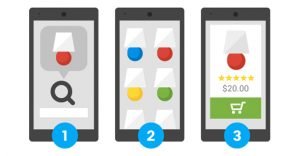How to Optimize Your Website for Mobile Traffic

These days, if you don’t have a mobile version of your website, you’re losing out on a lot of traffic. Nearly a third of all Internet traffic, and over half of all Facebook traffic, comes from mobile devices. That number is growing steadily every year, and promises to keep increasing as mobile technology improves and wearable technology debuts. Mobile traffic is especially valuable for local businesses, as a huge part of mobile use is for local search. If that’s not a good enough reason to cater to mobile, just remember, having a mobile version of your site is a general search ranking factor as well.
Convinced? Here are some ideas on how you can cater to mobile traffic.
Decide Between a Dedicated Site or a Responsive Design
The first choice you need to make is between having a dedicated mobile site on a subdomain, or a responsive design that works for all devices.
A dedicated mobile website is comparatively easy to create, as it’s just a streamlined, pared-down version of your site. It displays on a url of its own, such as www.m.example.com. There are services that will take your existing desktop site and create a mobile site from it. A mobile site has a few drawbacks, however, such as the fact that you have to maintain two sites on two URLs instead of one. If you change a piece of content, you need to change it in both locations. It also needs to work on a wide variety of devices with different capabilities and screen sizes.
A responsive site is much more dynamic. It’s made up of special code that detects the size of the window of the user’s browser and removes content and streamlines the site to make it fit. Below a certain size, it will prune out multimedia and rich content. Smaller, and it reorganizes text and images. Smaller yet and it’s an extremely bare-bones site. Responsive design is expensive to develop and maintain, but it’s more likely to work on more devices over time.
Whichever you pick, you need to implement other aspects of mobile SEO.
Keyword Emphasis: Short Keywords
Typing on a mobile device, compared to typing on a full-size desktop keyboard, is difficult. With the risk of typos and the increased time it takes to type, mobile users tend to use the absolute minimum required for a query. If you want to cater to their habits, you should focus on the shortest keywords you can. Unfortunately, this means a reduced emphasis on long-tail keywords. Also unfortunately, shorter keywords tend to be much more competitive.
Keyword Emphasis: Local Keywords
Another emphasis you should make when catering to mobile devices is local. A huge amount of mobile search traffic is specifically geared towards local traffic. If your business has no local location to play on, you’re out of luck here. On the other hand, if you have a physical location and can optimize around it, you’re going to have an advantage over general or global companies that don’t focus on your area.
Keyword Emphasis: Semantic Search
Google’s Hummingbird algorithm update was a dip of their toes into the world of mobile semantic search. Semantic search is a stark contrast to what normal search looks like. Picture, for example, Siri or Google Now. Instead of typing a few keywords, the user asks a full, plain English question. Google then interprets that question as best it can and pulls the best content it can find. Semantic search is your attempt to cater to those plain English questions.
Front-Load Content Value
Mobile users don’t like having to dig for their content. They don’t like having to scroll repeatedly through lengthy content, particularly if that content isn’t formatted for easy skimming. The more easily they can find what they’re looking for – the closer to the top of the page it is, and the more it’s formatted to stand out – the more likely they will be to return and keep your site in mind.
Make Use of Mobile Features
Mobile devices offer a number of features that aren’t applicable to the standard desktop user. You should configure your mobile site to take advantage of those features. For example:
- Click to call functionality allows a user to click a phone number and have their smartphone automatically dial the number.
- Mobile coupons allow a user to access special in-store advertising via their smartphone, for an additional discount in store immediately.
- Store locators aren’t unique to mobile, but making them primary in your mobile site helps cater to one of the most common uses of a mobile site.
- Barcode and QR code scanners allow a smartphone to look up item information on the fly, without needing to use in-store scanners or taking an item up to a register.
Consider a Task App
Do your users typically visit your mobile site with one or two particular tasks in mind? Consider creating an app that allows them to perform those tasks. You can advertise that app, or you can sell it for a small fee, to create an additional revenue stream.
One thing you should avoid doing, however, is hiding your website content and forcing the app. Google can’t index in-app content, and indeed won’t try. If you remove highly useful functions from your site just to sell an app, you’ll lose a corresponding amount of organic traffic.
Streamline Code for Faster Loads
Your mobile site needs to load quickly. Mobile users, more so than even desktop users, have a very short attention span and a very low tolerance for slow loading. The longer it takes your site to load, the more likely it is that a user will back out and find a different site offering the information they need. In many cases, this will be your direct competitor.
Test on Various Devices
There are dozens of types of devices out there. You have your smartphones, your tablets and your hybrids. You even have game systems that offer web browsing. You have your Android devices and your Apple devices. You have users of various browsers and with all ranges of screen sizes. You need to test your website on a wide range of such devices, to make sure it functions properly on as many of them as possible. You can’t possibly test on every device, but you can test on each of the major categories to anticipate and fix any errors.
 ContentPowered.com
ContentPowered.com






